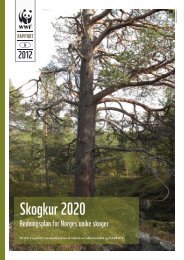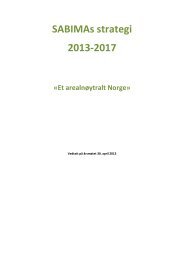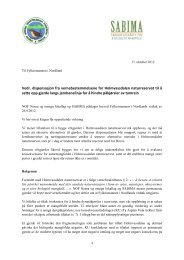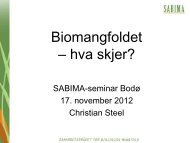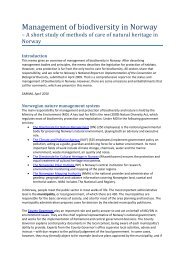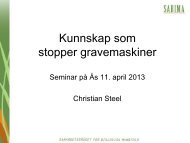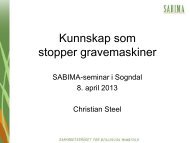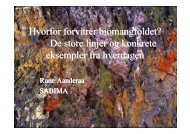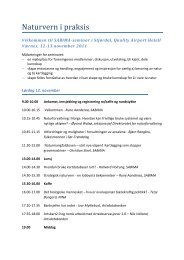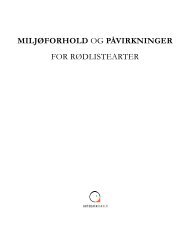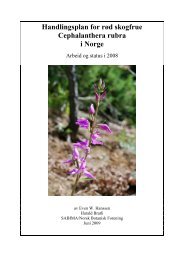Biodiversity, carbon storage and dynamics of old northern ... - BPAN.fi
Biodiversity, carbon storage and dynamics of old northern ... - BPAN.fi
Biodiversity, carbon storage and dynamics of old northern ... - BPAN.fi
Create successful ePaper yourself
Turn your PDF publications into a flip-book with our unique Google optimized e-Paper software.
ing age. A few eddy covariance studies <strong>of</strong> <strong>old</strong> (>200 yrs) temperate forests<br />
in North America indicate ecosystem <strong>carbon</strong> accumulation rates <strong>of</strong> about<br />
150–500 g C m -2 yr -1 . Repeated sampling <strong>of</strong> soil <strong>carbon</strong> in a temperate beech<br />
forest (250 yrs) <strong>and</strong> a boreal spruce forest (90 yrs), both unmanaged, indicates<br />
soil <strong>carbon</strong> accumulation rates <strong>of</strong> 60–160 g C m -2 yr -1 . Indirect evidence<br />
from several chronosequence studies indicates ecosystem <strong>carbon</strong><br />
accumulation rates <strong>of</strong> about 4.5–170 g C m -2 yr -1 for forests 120 to >200<br />
years <strong>old</strong>, with the lowest values for the <strong>old</strong>est forests. Comparisons <strong>of</strong> forest<br />
st<strong>and</strong>s <strong>of</strong> different ages also indicate that <strong>old</strong>er forests have higher <strong>carbon</strong><br />
stocks than younger forests. Although changes in soil or total ecosystem<br />
<strong>carbon</strong> stocks are dif<strong>fi</strong>cult to monitor, <strong>and</strong> the various methods have their<br />
problems, the consistent direction <strong>of</strong> the results <strong>of</strong> the various studies provide<br />
convincing evidence that <strong>old</strong> forests function as <strong>carbon</strong> sinks for a long<br />
time. The <strong>carbon</strong> stocks in biomass <strong>of</strong> <strong>old</strong> forests continue to increase with<br />
age, possibly for several hundred years, although the rate <strong>of</strong> biomass accumulation<br />
<strong>and</strong> thus the <strong>carbon</strong> sink will decrease with increasing age. Also,<br />
<strong>carbon</strong> stocks <strong>of</strong> forest soil <strong>and</strong> dead organic matter (especially coarse<br />
woody debris) appear to increase with st<strong>and</strong> age.<br />
Changes in forest biomass <strong>carbon</strong> stocks in boreal <strong>and</strong> <strong>northern</strong> temperate<br />
forests are largely determined by tree species <strong>and</strong> age <strong>of</strong> forest<br />
st<strong>and</strong>s, site productivity <strong>and</strong> disturbance history. Forest soil <strong>carbon</strong><br />
stocks are driven by site productivity <strong>and</strong> soil type (primarily driving<br />
litter production but also influencing decomposition), litter quality, <strong>and</strong><br />
local topography <strong>and</strong> disturbance history. The relationships between<br />
external drivers <strong>and</strong> soil <strong>carbon</strong> stocks are complex, <strong>and</strong> it is therefore<br />
dif<strong>fi</strong>cult to describe clear patterns in the response <strong>of</strong> soil <strong>carbon</strong> stocks<br />
to such drivers. Generally, variation in soil <strong>carbon</strong> stocks with environmental<br />
drivers is most pronounced for the organic layer, less so for the<br />
mineral soil <strong>and</strong> total soil <strong>carbon</strong> stocks.<br />
Effects <strong>of</strong> harvesting on <strong>carbon</strong> stocks<br />
Modern forest management incorporates various management<br />
measures which influence <strong>carbon</strong> stocks <strong>and</strong> fluxes. The most fundamental<br />
effect comes with the removal <strong>of</strong> biomass from the forest, directly<br />
reducing the biomass <strong>carbon</strong> stocks. Harvesting produces considerable<br />
amounts <strong>of</strong> logging residue <strong>of</strong> various sizes. Most <strong>of</strong> it will be <strong>of</strong> small<br />
dimensions <strong>and</strong> decompose rather quickly over a decade or so, but<br />
stumps represent coarse woody debris with a slow decay rate (lasting<br />
up to a century). The <strong>carbon</strong> from logging debris <strong>and</strong> natural litter production<br />
will partly be incorporated into the soil organic matter, <strong>and</strong><br />
partly be released to the atmosphere as CO 2. It is less clear how soil <strong>carbon</strong><br />
stocks respond to the harvesting event as such. After the <strong>fi</strong>rst rush<br />
<strong>of</strong> logging residues, little additional litter will be produced in a clear-cut<br />
st<strong>and</strong> for some decades. During the <strong>fi</strong>rst few decades, decomposition <strong>of</strong><br />
litter <strong>and</strong> soil organic matter will exceed production <strong>of</strong> biomass <strong>and</strong> the<br />
overall <strong>carbon</strong> stock will decline. Some studies indicate that the amount<br />
<strong>Biodiversity</strong>, <strong>carbon</strong> <strong>storage</strong> <strong>and</strong> <strong>dynamics</strong> <strong>old</strong> <strong>northern</strong> forests 11



